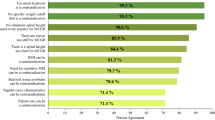Abstract
Study Design
Expert consensus building using combined Delphi method and Nominal group technique.
Objectives
To identify the current state of equipoise surrounding the use of magnetically controlled growing rods (MCGRs) and to determine consensus for planning a randomized controlled trial (RCT) with MCGRs.
Background
The use of MCGRs for the treatment of early-onset scoliosis (EOS) is a new technology. Optimal use has not been thoroughly investigated and much uncertainty exists. Areas of uncertainty include construct architecture, timing of lengthenings, and amount of distraction per lengthening. Expert discussion and consensus is useful at this early juncture and necessary when designing an RCT.
Methods
Two rounds of surveys were administered to a group of experienced pediatric spine surgeons, followed by a 2-hour, face-to-face meeting in November 2015 and a 1-hour, face-to-face meeting in February 2016. The first survey used example cases to establish agreement around the proper use of MCGRs and identified areas of equipoise and disagreement. The second survey again used example cases—this time selected for their equipoise status—to solicit trial arms for a potential RCT of MCGRs and identified important open questions in the use of MCGRs. Lastly, the face-to-face meetings employed iterative voting to preliminarily plan an RCT of MCGRs.
Results
Following the Delphi survey rounds and the two Nominal face-to-face meetings, the group of experts decided on an MCGR RCT design that standardized all patients to bidirectional constructs, and randomized to a lengthening interval of 6 versus 16 weeks with a standardized equation for calculating the total yearly lengthening that approximates normal spine growth.
Conclusion
This endeavor indicates expert support for the use of MCGR in children older than 6 years, with curves greater than 60°. The uncertainty surrounding frequency of lengthening justifies an RCT of MCGRs.
Level of Evidence
Level V.
Similar content being viewed by others
References
Harrington PR. Treatment of scoliosis. Correction and internal fixation by spine instrumentation. J Bone Joint Surg Am 1962;44: 591–610.
Moe JH, Kharrat K, Winter RB, Cummine JL. Harrington instrumentation without fusion plus external orthotic support for the treatment of difficult curvature problems in young children. Clin Orthop Relat Res 1984;185:35–45. http://www.ncbi.nlm.nih.gov/pubmed/6705397. Accessed April 5, 2011.
Skaggs DL, Akbarnia BA, Flynn JM, et al. A classification of growth friendly spine implants. J Pediatr Orthop 2014;34:260–74.
Yang JS, McElroy MJ, Akbarnia BA, et al. Growing rods for spinal deformity: characterizing consensus and variation in current use. J Pediatr Orthop 2010;30:264–70.
Tis JE, Karlin LI, Akbarnia BA, et al. Early onset scoliosis: modern treatment and results. J Pediatr Orthop 2012;32:647–57.
Bess S, Akbarnia BA, Thompson GH, et al. Complications of growing-rod treatment for early-onset scoliosis: analysis of one hundred and forty patients. J Bone Joint Surg Am 2010;92: 2533–43.
Matsumoto H, Williams BA, Corona J, et al. Psychosocial effects of repetitive surgeries in children with early-onset scoliosis: Are we putting them at risk? J Pediatr Orthop 2014;34:172–8.
Flynn JM, Matsumoto H, Torres F, et al. Psychological dysfunction in children who require repetitive surgery for early onset scoliosis. J Pediatr Orthop 2012;32:594–9.
Sankar WN, Skaggs DL, Yazici M, et al. Lengthening of dual growing rods and the law of diminishing returns. Spine (Phila Pa 1976) 2011;36:806–9.
Takaso M, Moriya H, Kitahara H, et al. New remote-controlled growing-rod spinal instrumentation possibly applicable for scoliosis in young children. J Orthop Sci 1998;3:336–40.
Akbarnia BA, Mundis GM, Salari P, et al. Innovation in growing rod technique: a study of safety and efficacy of a magnetically controlled growing rod in a porcine model. Spine (Phila Pa 1976) 2012;37: 1109–14.
Cheung KMC, Cheung JPY, Samartzis D, et al. Magnetically controlled growing rods for severe spinal curvature in young children: a prospective case series. Lancet 2012;379:1967–74.
Su AW, Milbrandt TA, Larson AN. Magnetic expansion control system achieves cost savings compared to traditional growth rods: an economic analysis model. Spine (Phila Pa 1976) 2015;40: 1851–6.
Rolton D, Richards J, Nnadi C. Magnetic controlled growth rods versus conventional growing rod systems in the treatment of early onset scoliosis: a cost comparison. Eur Spine J 2015;24: 1457–61.
Charroin C, Abelin-Genevois K, Cunin V, et al. Direct costs associated with the management of progressive early onset scoliosis: estimations based on gold standard technique or with magnetically controlled growing rods. Orthop Traumatol Surg Res 2014;100: 469–74.
Cheung JP, Cahill P, Yaszay B, et al. Special article: Update on the magnetically controlled growing rod: tips and pitfalls. J Orthop Surg (Hong Kong) 2015;23:383–90.
Freedman B. Equipoise and the ethics of clinical research. N Engl J Med 1987;317:141–5.
Vitale MG, Riedel MD, Glotzbecker MP, et al. Building consensus: development of a best practice guideline (BPG) for surgical site infection (SSI) prevention in high-risk pediatric spine surgery. J Pediatr Orthop 2013;33:471–8.
Vitale MG, Skaggs DL, Pace Gl, et al. Best practices in intraoperative neuromonitoring in spine deformity surgery: development of an intraoperative checklist to optimize response. Spine Deform 2014;2: 333–9.
Hasson F, Keeney S, McKenna H. Research guidelines for the Delphi survey technique. J Adv Nurs 2000;32:1008–15.
Van de Ven AH, Delbecq AL. The nominal group as a research instrument for exploratory health studies. Am J Public Health 1972;62:337–42.
Akbarnia BA, Yazici M, Thompson GH. The Growing Spine: Management of Spinal Disorders in Young Children. New York: Springer Science & Business Media; 2010, https://books.google.com/books?id=y7u6Esp7alEC&pgis=1. Accessed February 22, 2016.
Author information
Authors and Affiliations
Corresponding author
Additional information
Author disclosures: NF (none); HM (none); CWH (none); TSH (none); JP (none); JRS (none); BAA (none); DLS (none); BDR (none); DPR (none); MGV (none).
This work is supported by a grant from Ellipse Technologies, the manufacturer of the magnetically controlled growing rod device discussed in this work.
Rights and permissions
About this article
Cite this article
Feinberg, N., Matsumoto, H., Hung, C.W. et al. Expert Consensus and Equipoise: Planning a Randomized Controlled Trial of Magnetically Controlled Growing Rods. Spine Deform 6, 303–307 (2018). https://doi.org/10.1016/j.jspd.2017.11.002
Received:
Revised:
Accepted:
Published:
Issue Date:
DOI: https://doi.org/10.1016/j.jspd.2017.11.002




